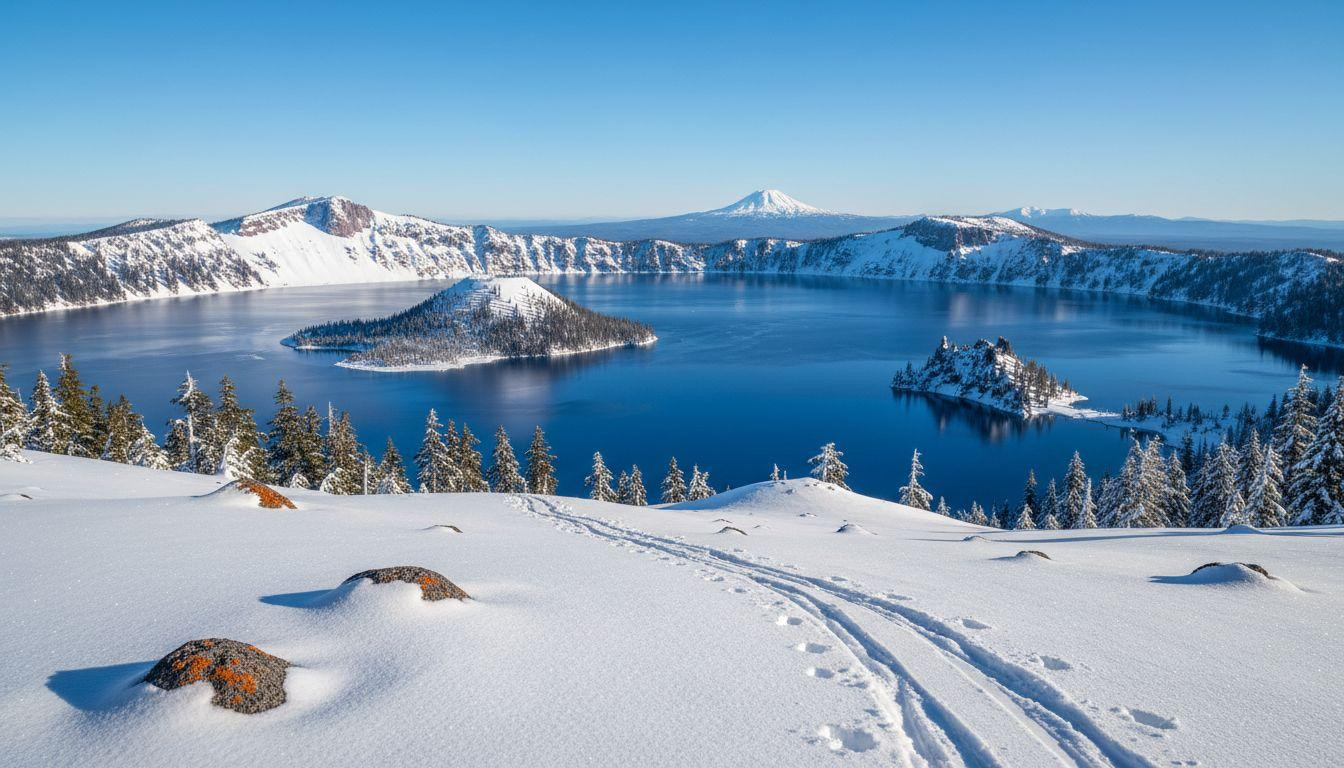When Crater Lake’s Rim Drive closes in November, something extraordinary happens. The tourists disappear, the noise stops, and 43 feet of annual snow transforms Oregon’s most famous overlook into a frozen sanctuary. Cloudcap Overlook becomes accessible only by backcountry skis, creating the kind of profound solitude that modern travelers crave but rarely find.
Winter strips away everything except the essential. The summer crowds of 500-700 daily visitors vanish. In their place: silence, snow, and views that stretch beyond the horizon.
Where winter transforms accessibility into exclusivity
Cloudcap Overlook sits at 8,000 feet on Crater Lake’s eastern rim. Summer brings tour buses and paved access. Winter changes everything with a simple equation: 43 feet of snow minus road maintenance equals extreme solitude.
The approach requires 8.2 miles of backcountry skiing from Rim Village. Elevation gain: 1,200 feet. Duration: 4-5 hours each way. The reward justifies every step.
Only 35-40 backcountry skiers attempt this journey monthly during peak season. Compare this to summer’s daily stampede, and you understand winter’s gift: authentic wilderness access without compromise.
What 43 feet of snow reveals about Oregon’s crown jewel
Crater Lake never freezes. Even at -20°F, the 1,949-foot-deep waters remain liquid. This creates winter’s most striking visual: snow-buried landscape surrounding brilliant cobalt water. The contrast burns itself into memory.
The visual transformation
Morning alpenglow arrives between 7:30-7:45 AM. Sunrise light catches snow crystals on Wizard Island, creating what locals describe as “diamond dust effects.” The frozen surface reveals subtle blue ice patterns invisible during summer visits.
Phantom Ship rock formation emerges dramatically from snowdrifts. The caldera’s eastern exposure creates extraordinary visibility: 100+ miles on clear days, revealing mountain ranges that appear deceptively close.
The acoustic sanctuary
Winter at Cloudcap is defined by sound’s absence. Snow’s acoustic properties create what visitors consistently describe as “cathedral-like quiet.” Only wind through snow-laden conifers and distant avalanche rumbles in remote gullies break the silence.
The quality shifts visitors’ internal state. Hours pass unnoticed. Temporal disorientation becomes common. This profound quiet creates conditions where landscape registers with heightened emotional impact.
The earned solitude experience
Physical challenge intensifies sensorial reward. Multi-hour ski expeditions create psychological conditions where every vista feels personally discovered. This isn’t observation: it’s communion.
Essential preparation
Required gear includes avalanche transceiver, probe, shovel, and ice axe for cornice hazards. Glacier glasses protect against UV reflection off snow. The nearest avalanche beacon rentals: Crater Lake Country Store in Prospect ($15/day) or Mazama Sports in Klamath Falls ($12/day).
Moderate avalanche risk exists on east-facing slopes below Garfield Peak. Avoid during or after major storms. January offers deepest snow and most stable conditions. February provides improved daylight and fewer storms.
The logistics of isolation
Crater Lake National Park charges $30 per vehicle for seven-day access. No additional permits required for day use. Nearest full services: Klamath Falls, 70 miles away. Prospect offers limited options at 28 miles.
Winter access demands self-sufficiency. Plan accordingly for severe weather, potential isolation, and limited rescue options.
Why winter creates Oregon’s most exclusive viewpoint
Summer’s accessibility becomes winter’s barrier. Road closures from November through May eliminate casual visitors. The result: 99.9% decrease in visitation compared to summer months.
This transformation reveals Crater Lake’s true character. Without crowds, commerce, or tourism infrastructure filtering the experience, visitors encounter landscape in its most honest state. Winter strips away everything except the essential encounter between human and wilderness.
The physical challenge of earning access through multi-hour expeditions creates conditions where every moment registers with heightened clarity. Boundaries define the experience rather than limiting it.
Your questions about Cloudcap Overlook winter answered
How difficult is winter access to Cloudcap Overlook?
Advanced backcountry skiing skills required. The 8.2-mile approach involves 1,200 feet elevation gain over unplowed Rim Drive. Allow 4-5 hours each way. Weather changes rapidly at 8,000 feet elevation. Self-rescue capability essential.
When does winter access season begin and end?
Rim Drive typically closes November 1 or earlier with significant snowfall. Backcountry ski access opens once 2+ feet of consolidated snowpack forms, usually late December. Season runs through March. Crews begin snow removal in April, but opening dates vary significantly with weather conditions.
How does winter Cloudcap compare to summer overlooks in the Cascades?
Winter eliminates the crowds but multiplies the challenge. Summer sees 500-700 daily visitors at Cloudcap. Winter averages 12-15 people weekly. Physical demands increase 3x, but reward includes authentic solitude impossible during accessible months. Costs remain minimal: $30 park entry versus hundreds for guided summer experiences elsewhere.
The wind dies for precious minutes. Complete silence settles over the caldera. Snow crystals catch morning light, transforming the entire landscape into crystalline brilliance that makes you forget the effort required to witness it.
